Shalom from Kibbutz Zova
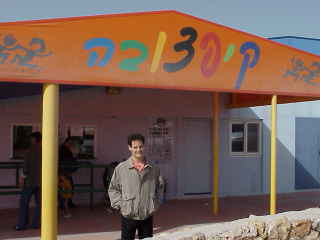 (Because Monica was busy uploading images, etc., and there was another
PC available, Adam decided to write this day's installment. The
following are his impressions. Any new comments are noted as such and
were written by Monica.)
(Because Monica was busy uploading images, etc., and there was another
PC available, Adam decided to write this day's installment. The
following are his impressions. Any new comments are noted as such and
were written by Monica.)
Saturday, Monica, Akiva, and I went to the kibbutz. For those of you not "in the know," a kibbutz is a Zionist Jewish social cooperative with shared work, living, and social life--one of the only examples in the world of multiple, simultaneous, successful experiments in commune living. Kibbutz Palmach Zova (pronounced PAHL-mock TZOO-buh by the Israelis), in particular, was the kibbutz to which Grandma Libbie Zucker's community donated a tractor when she was young. Her father, Morris Dunn, was the head of the New Britain, Conn., Zionist movement.
(Monica notes: By the way, the photo to the right/above is of Kifzova, a kids' play area kind of luck Chuck E. Cheese, except without the pizza. We were there on a weekend, so there were a lot of parents with their kids. It's apparently a relatively new addition to the kibbutz, and rather a decent money-maker, and it was the first time Akiva had visited it. In fact, the next few pictures are of Kifzova and of us at the place; I particularly like the computer room area--not something I would expect to see at Chuck E. Cheese's!)
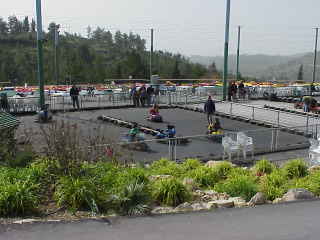 Morris Dunn helped to raise the funds and (as we learned from Akiva) New Britain was matched by
the Jewish Agency with Zova. He visited early in Israel's existence in
the 1950s to deliver the tractor they bought with the funds. That donation is our connection with Akiva Ilan.
Morris Dunn helped to raise the funds and (as we learned from Akiva) New Britain was matched by
the Jewish Agency with Zova. He visited early in Israel's existence in
the 1950s to deliver the tractor they bought with the funds. That donation is our connection with Akiva Ilan.
He was a young man at the time living on the kibbutz, and he met Morris Dunn and later met and kept in touch with my grandparents, Libbie and Sidney.
So there was a lot of history behind the
visit.
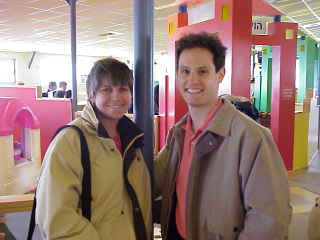 At the beginning, the Kibbutz was agricultural, but it now survives on other
sources of income. Some time in the 1980s, they opened a highly successful car
windshield glass manufacturing plant, catering to the replacement glass market
(which was quite in demand during the intifada, apparently, Akiva said!).
At the beginning, the Kibbutz was agricultural, but it now survives on other
sources of income. Some time in the 1980s, they opened a highly successful car
windshield glass manufacturing plant, catering to the replacement glass market
(which was quite in demand during the intifada, apparently, Akiva said!).
The kibbutz also makes furniture, and after we returned we saw an ad in the Jerusalem Post advertising its wares!
As you can see in the above pictures, the kibbutz has now also branched out into kids'
entertainment. This kiddie amusement park, with its kiddie bumper cars,
is run by the Kibbutz, and the profits are shared among Kibbutz members.
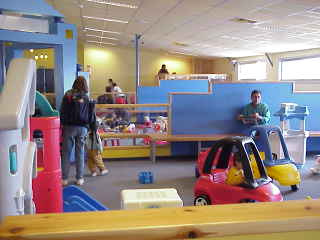 Monica, of course, thought the kids were extremely cute and had to take lots of
pictures. (The kids were really cute, to her credit.) They have an indoor play
center with a ball pool, a foam play area, complete Barbie and doll sets,
computers with kids' computer games, and much more. Monica was impressed with
how technological a society Israel now is.
Monica, of course, thought the kids were extremely cute and had to take lots of
pictures. (The kids were really cute, to her credit.) They have an indoor play
center with a ball pool, a foam play area, complete Barbie and doll sets,
computers with kids' computer games, and much more. Monica was impressed with
how technological a society Israel now is.
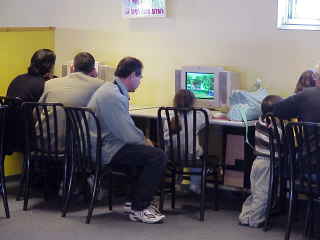 Akiva's son Danny works in Motorola's
chip manufacturing division in Tel Aviv, and high tech now represents a
significant (and rapidly growing) portion of the economy. Everywhere, we saw
evidence of technology usage potentially much more advanced than that of the U.S.
Akiva's son Danny works in Motorola's
chip manufacturing division in Tel Aviv, and high tech now represents a
significant (and rapidly growing) portion of the economy. Everywhere, we saw
evidence of technology usage potentially much more advanced than that of the U.S.
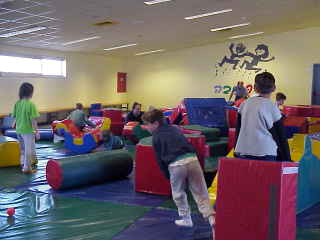 An interesting side note: the laws in Israel favor the Kibbutz life, so when I said that profits are divided among Kibbutz members, that fact works to their
advantage. If one member makes $1000 and one makes $99,000, the divided income
is $50,000 for each, so the effective tax rate is lower for the well-paid member.
An interesting side note: the laws in Israel favor the Kibbutz life, so when I said that profits are divided among Kibbutz members, that fact works to their
advantage. If one member makes $1000 and one makes $99,000, the divided income
is $50,000 for each, so the effective tax rate is lower for the well-paid member.
 This factor works to the Kibbutz's overall advantage since some members (such as
children, internal workers who are paid in the Kibbutz scrip, and retired or ill
people) earn no income at all.
This factor works to the Kibbutz's overall advantage since some members (such as
children, internal workers who are paid in the Kibbutz scrip, and retired or ill
people) earn no income at all.
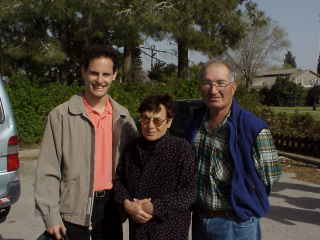 When we drove up to the main living center of the Kibbutz, we happened to meet
Tzipora Israeli and her husband Ilan. She remembered Libbie from many past visits
and sends her best regards. Tzipora is in her 70s, according to Akiva, but she
certainly doesn't look it.
When we drove up to the main living center of the Kibbutz, we happened to meet
Tzipora Israeli and her husband Ilan. She remembered Libbie from many past visits
and sends her best regards. Tzipora is in her 70s, according to Akiva, but she
certainly doesn't look it.
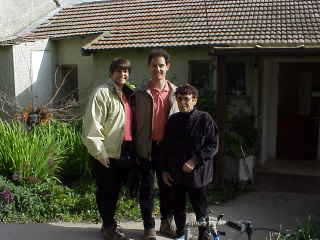 Tzipora, like Akiva, was one of the founding members of
the kibbutz. Unlike Akiva, she has spent her entire life living there. As a
matter of fact, Akiva said that she actually broke off a serious relationship
many years ago when her near-fiance demanded that they live in Jerusalem
instead of on the kibbutz.
Tzipora, like Akiva, was one of the founding members of
the kibbutz. Unlike Akiva, she has spent her entire life living there. As a
matter of fact, Akiva said that she actually broke off a serious relationship
many years ago when her near-fiance demanded that they live in Jerusalem
instead of on the kibbutz.
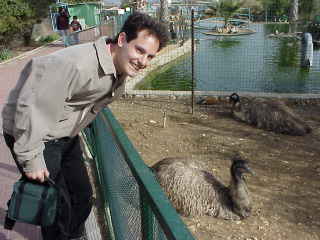 Tzipora is a really sweet woman. She invited us in to her apartment any time
we wanted to (unfortunately, we ran out of time).
Tzipora is a really sweet woman. She invited us in to her apartment any time
we wanted to (unfortunately, we ran out of time).
Along with the kiddie play park, the Kibbutz runs a small zoo for the kids.
It is apparently not doing nearly so well. I can sort of see why. For one thing, it would
be hard to find; also, there are really no interesting signs or displays; and finally,
it is kind of small and dirty. We still had fun, of course.
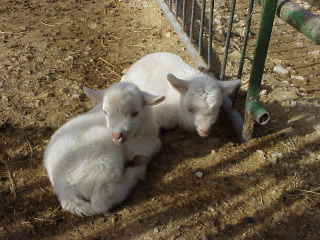 I can watch monkeys all day long (no comments, please),
and Monica thought the baby goats were soooooo cute. Akiva seemed mildly if not extremely amused by our excitement. Unlike the kiddie play park, we only saw about four
kids (children, that is; not baby goats) in the zoo. After the stench began to get to us, we left.
I can watch monkeys all day long (no comments, please),
and Monica thought the baby goats were soooooo cute. Akiva seemed mildly if not extremely amused by our excitement. Unlike the kiddie play park, we only saw about four
kids (children, that is; not baby goats) in the zoo. After the stench began to get to us, we left.
 Across the way, they have a new, concrete and glass dining hall seating more people more comfortably than the old dining hall could.
Some interesting bits of info about the Kibbutz that we
learned in that new dining hall. First, Akiva pointed out a list of requests for
rides on a sheet of paper. Because of the limited transportation capabilities on
the Kibbutz, anyone who wants a ride posts the times and dates on the sheet, and
everybody shares. I wish DC traffic worked that way. Second, Akiva mentioned
that whereas once upon a time, everyone ate all four meals (after-work jam and
bread snack is one) together, now most people eat the jam and bread in their
rooms. Furthermore, many people now eat breakfast in the rooms. Just one more
way in which the communality of Kibbutz life is slowly fading.
Across the way, they have a new, concrete and glass dining hall seating more people more comfortably than the old dining hall could.
Some interesting bits of info about the Kibbutz that we
learned in that new dining hall. First, Akiva pointed out a list of requests for
rides on a sheet of paper. Because of the limited transportation capabilities on
the Kibbutz, anyone who wants a ride posts the times and dates on the sheet, and
everybody shares. I wish DC traffic worked that way. Second, Akiva mentioned
that whereas once upon a time, everyone ate all four meals (after-work jam and
bread snack is one) together, now most people eat the jam and bread in their
rooms. Furthermore, many people now eat breakfast in the rooms. Just one more
way in which the communality of Kibbutz life is slowly fading.
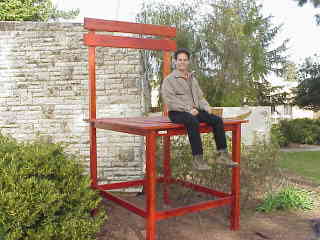 Artwork in the yard. I had to play, of course. When I climbed on top, Akiva said
"well, maybe we can make a Palmach out of you yet." The Palmach is the
Israeli elite military strike force, kind of like the Navy SEALs in the U.S. Some
of you smart folk will remember from the beginning of this writing that the name
of the Kibbutz is actually Palmach Zova. It was called Palmach because it was
started by a group of Palmach soldiers. Interestingly, Akiva explained the
Palmach seal to us (two stalks of grain and a sword). The Palmach was the first
self-funded military force is Israel, supporting itself by Kibbutz farm work.
The symbol represents two days of work in the fields for one day of military
training (the deal at the time).
Artwork in the yard. I had to play, of course. When I climbed on top, Akiva said
"well, maybe we can make a Palmach out of you yet." The Palmach is the
Israeli elite military strike force, kind of like the Navy SEALs in the U.S. Some
of you smart folk will remember from the beginning of this writing that the name
of the Kibbutz is actually Palmach Zova. It was called Palmach because it was
started by a group of Palmach soldiers. Interestingly, Akiva explained the
Palmach seal to us (two stalks of grain and a sword). The Palmach was the first
self-funded military force is Israel, supporting itself by Kibbutz farm work.
The symbol represents two days of work in the fields for one day of military
training (the deal at the time).
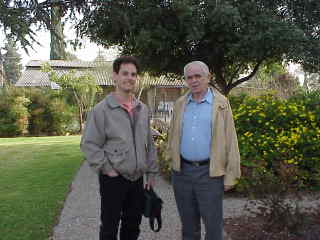 This dilapidated dining hall is the cavernous room in which I remember having
Pesach some 20 years ago when I was six years old. I guess things never look as
big when you grow older. The kibbutz now uses this dining hall as storage. Akiva
also took us down to the old set of houses, now in disuse, in which he lived
many years ago when he helped found the kibbutz. He said, "Looking at these
houses, I can't believe we lived here, but we did. Times have really changed."
Even though he visits the kibbutz all the time, I think the visits can still
be a little emotional for Akiva.
This dilapidated dining hall is the cavernous room in which I remember having
Pesach some 20 years ago when I was six years old. I guess things never look as
big when you grow older. The kibbutz now uses this dining hall as storage. Akiva
also took us down to the old set of houses, now in disuse, in which he lived
many years ago when he helped found the kibbutz. He said, "Looking at these
houses, I can't believe we lived here, but we did. Times have really changed."
Even though he visits the kibbutz all the time, I think the visits can still
be a little emotional for Akiva.
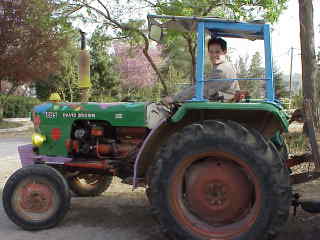 Of course, we had to get a picture on a tractor to close the loop with history.
(The original tractor donated by the Dunn's and New Britain, was obviously much larger.) Granny has the old picture still if anybody is interested.
Of course, we had to get a picture on a tractor to close the loop with history.
(The original tractor donated by the Dunn's and New Britain, was obviously much larger.) Granny has the old picture still if anybody is interested.
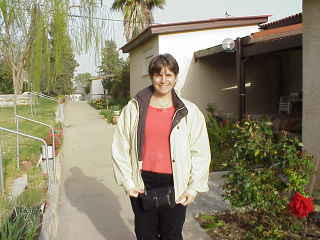 One more note to Granny: We're sorry to say we were unable to see
Amnon, another of the long-time kibbutzniks. We stopped by but he was
not there (or napping; it was the afternoon); we took a picture, at least.
Anyway, Amnon sends his best (by
phone); we hope to see him next time we are in the area.
One more note to Granny: We're sorry to say we were unable to see
Amnon, another of the long-time kibbutzniks. We stopped by but he was
not there (or napping; it was the afternoon); we took a picture, at least.
Anyway, Amnon sends his best (by
phone); we hope to see him next time we are in the area.
And so ended Day 7 (March 20).
To continue your cybertour, click here.
To go back to the previous page, click here.
To go to the original homepage, click here.
TO go to the revised homepage, click here.
And, of course, feel free to write to us.
Last updated on July 4, 1999.